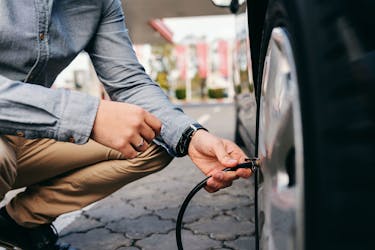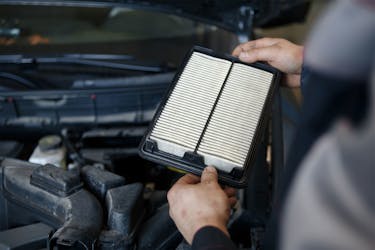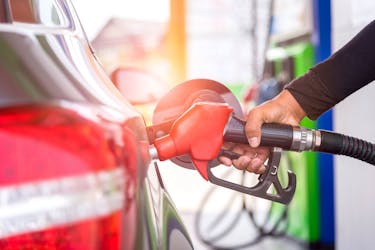

Get Access to 250+ Online Classes
Learn directly from the world’s top investors & entrepreneurs.
Get Started NowIn This Article
- #1: Check Tire Pressure
- #2: Utilize Fuel Injector Cleaner
- #3: Clean or Replace Your Air Filter
- #4: Take Advantage of Tax Deductions
- #5: Find Cheap(er) Gas
- #6: Lighten the Load
- #7: Carpool
- #8: Make Housing Changes
- #9: Work from Home
- #10: Buy a Fuel-Efficient or Electric Car
- The Bottom Line: How to Save Money on Gas
Most Americans today are wondering the same question on their morning and evening commutes: how to save money on gas.
On average, the daily commute for an American driver is 26.1 minutes one way. That equates to 261 minutes — over 4 hours — in the car for those working five days a week.
That’s over 4 hours of wear and tear on a vehicle each week along with paying for the expense of gas.
Depending upon the mileage, the ever-changing price of gas and the vehicle’s miles per gallon (MPG), this alone can add up to thousands of dollars per year. In California, gas prices are topping out at $5.86 per gallon, and the national average currently sits at $4.25 per gallon.
There’s no sign they are slowing either.
The record-breaking gas increases are felt every time workers head to the pump. For many workers, the cost of filling their tanks is more than they make in a shift. It can feel like an impossible situation.
But if you’re wondering how to save money on gas, here’s the good news: small changes can add up.
While you may not be able to change how far away you live from work easily, there are ways to save gas money at the pump and make driving a little easier on your wallet — you just have to know how.
Here’s 10 answers to those wondering how to save money on gas.

#1: Check Tire Pressure
Believe it or not, tire pressure plays a significant role in getting the best gas mileage your vehicle.
It’s one of many solutions to those wondering how to save money on gas.
When vehicle tires are under-inflated, it requires your car to use more effort to push itself forward.
Not only does this result in poor gas mileage, thus costing you to pay for more gas more often; it can also be a major safety concern that can result in thousands of dollars of repairs.
It’s important to check your tire pressure at least once a month and inflate air to the specific PSI (Pounds per Square Inch) recommended in your car manual.
Some gas stations even have free air pumps that you can use to inflate your tires if you don’t have an inexpensive air pump at home.
How to Save Money on Gas: Check Your PSI
To check the PSI in your tires, you can either measure it at air pumps found at a gas station or buy a small tire pressure gauge for only a few dollars.
We recommend the small purchase — they can come in handy and for little cost. These are available at most auto parts stores as well as gas stations.
You simply take the cap off the stem valve sticking out of your wheel and push the gauge down on the stem. The gauge will have a stick-like measuring piece that will elevate and shows what pressure the tires are. If you haven’t done it before, just know that it’s as easy as checking the air in a basketball!
Keeping your tires inflated to their proper PSI and increasing your MPG is one of the most effective ways to save money on gas.
While the average PSI is 35, it’s important to find out the proper number from your car manual.
Do this once a month for all four of your tires to ensure maximum results.
Keeping your tires inflated to the proper PSI will actually result in less wear and tear on your tires, which means that you may not have to replace them as often (prices range from $50-200 per tire), further increasing your savings on your wallet.
#2: Utilize Fuel Injector Cleaner
Another answer if you’re wondering how to save money on gas: increase MPG with fuel injector cleaner.
Injectors are part of the engine's fuel delivery system that sprays gasoline into the engine and keeps the motor running.
Over time, these injectors can build up with dirt and debris and can cause lower performance or worse — deterioration. In either situation, the engine is using more gas, thus causing you to fill up your gas tank more often than usual.
That’s where fuel injector cleaner comes in: when applied, it cleans the dirt and debris that build up in the fuel system. These bottles of cleaner are cheap, ranging from only a few dollars a bottle to higher-end costing about $12 per bottle.
How to Save Money on Gas: Apply Fuel Injector Cleaner
A good rule of thumb is that gas-injector cleaners should be used every 1,550 miles.
The first step to applying fuel injector cleaner is to purchase a bottle at your local auto store.
The next step is to wait until your gas tank gets low. After you pull up to the pump, pour the cleaner into the tank BEFORE you put gas in.
You want to do this so that when you put gas in your tank, it mixes with the cleaner.
When the engine burns this mix as you drive away from the pump, it will free up the dirt and debris that is clogging the injectors, allowing the motor to operate how it was meant to.
It will burn cleaner, run smoother, and increase your gas mileage — and help you save money on gas.
#3: Clean or Replace Your Air Filter

The air filter is an overlooked item in your vehicle when it comes to saving money on gas.
An air filter filters (tongue twister, I know) out particles in the air that could potentially get into your engine. In short, it helps your motor breathe for optimal performance.
Over time, these particles of dirt and pollution build up in the air filter, causing your car to struggle to have airflow — it’s like your car is suffocating from the lack of air.
Air filters can vary in price depending on your car, but your average air filter is anywhere from $50-$80.
How to Save Money on Gas: Change An Air Filter
While your local mechanic can change your air filter, it’s such an easy task that we recommend doing it yourself.
Here’s how. The first step is to find the air filter compartment under your hood. To do this, you can look in your car manual, which will have directions.
After you locate the compartment, take the top of it off. You can pull it out, examine how dirty it is, and either clean it or put a new one in. This task should take 10-15 minutes.
You can see an average increase of up to 10% on your fuel economy. It can also generate a fuel savings of close $0.15 per gallon at the fuel pump.
If you decide to clean your air filter instead of replacing it, all you need to do is use a hose to wash it out, buy a bottle of air filter oil (it comes in a spray), and spray down the air filter after it dries. Once you have washed it, you can put it back into the compartment and put the lid back on.
Cleaning or replacing an air filter is a simple answer to the question of how to save money on gas.
While learning these tasks on how to save money on gas, you are also learning basic car maintenance skills that will come in handy so that you can avoid paying a mechanic or technician for these minor changes.
#4: Take Advantage of Tax Deductions
There are three ways that you can deduct your mileage, which can lower your taxable income:
- If you are a business owner
- If you volunteer for a nonprofit
- If you are driving to medical appointments
Business Owner
Being a business owner helps you when thinking about how to save money on gas. An employee of a company, though, can not.
You can deduct your mileage in one of two ways:
- Total Expenses
- the Standard Mileage Rate
Total Expenses
These expenses include gas, maintenance, and repairs, fees for registration, insurance, depreciation and more.
If you expect high operating costs (gas, repairs, tires, etc.) for your vehicle, this method may be more financially beneficial than the standard mileage rate, which we’ll discuss next.
Standard Mileage Rate
The standard mileage rate is determined by the Internal Revenue Service (IRS) each year that you, the taxpayer, can deduct per mile driven for business.
For example, if you are driving to meet with a lawyer, clients or to the store for office supplies, you can deduct this mileage. You can’t deduct your mileage driving to and from your office — the IRS considers this commuting.
According to Turbotax, the more economical the vehicle is to operate, the more likely it is that the standard mileage rate will give you a bigger deduction.
The rates for mileage returns, which you can deduct on your return, have increased from 54.5 cents per mile driven in 2018, up to 58 cents per mile driven in 2019.
For this method, you’ll need to know the total number of miles you’ve driven during the year and the total number of miles driven for business.
Volunteering for a Non Profit
If you decide to lend a helping hand and volunteer with a nonprofit organization, you can deduct that mileage as part of your charitable donations.
The IRS will allow you to claim 14 cents per mile.
Medical
You can deduct your mileage for various medical appointments. You can claim 20 cents per mile driven.
#5: Find Cheap(er) Gas

This may seem like common sense, but it is another option that often gets overlooked when wondering how to save money on gas.
Because gas stations all set their own prices, you’ll experience that those closest to the interstate typically have higher prices than those down the road.
The difference of even 20 cents a gallon on a car that has a 13-gallon tank is a $2.60 difference every time you fill-up.
Now take that with your mileage rate back in step 4 if you are a business owner, it’s the equivalent of saving 78 cents per gallon!
There are apps you can download on your smartphone that will give you the gas prices in your area or your route if you need help seeing what the best prices are.
While we do recommend keeping your eyes open for a good deal, we don’t recommend driving around for too long in search of cheaper gas prices. This form of penny hoarding can actually do more harm than good by taking away your most valuable asset: time.
#6: Lighten the Load

The heavier your vehicle, the more work your motor has to do to pull all the car. The harder your motor works, the worse gas mileage you’ll get.
Don’t use your car as a storage center: if you have heavy items or other clutter in your car, clean it out.
And if you drive a truck or SUV and are currently looking for a new vehicle, a smaller, less heavy car can make your commute significantly cheaper — and be an answer to the question of how to save money on gas.
#7: Carpool

While carpooling may seem like an obvious solution, it has to be mentioned when thinking about how to save money on gas.
By carpooling with friends or coworkers, not only can you save money by not driving; you can lengthen the life of your vehicle by not putting as much wear and tear on it.
#8: Make Housing Changes

If you are renting for housing (meaning that you’re not locked into a mortgage or lease) and you find yourself commuting hours each day, it might be wise to make a move closer to your job where you could walk, bike or take the bus to work.
Even if housing is expensive, it might be cheaper in the long run to not pay as much for gas and other car maintenance.
For example, let’s say you pay $1,200 rent and spend $350/month on gas commuting to your job. If you find housing much closer to your job for $1,400/month and cut your gas bill to $50 per month, yes the rent is more expensive rent but the change is actually $100 cheaper than commuting.
Plus, you would save time by not driving, and with that time you could get in shape, learn more about investing, or increase your income with a side hustle.
#9: Work from Home
Another option when wondering how to save money on gas: In the U.S., 79% of people use a single-occupancy car to commute to work, which means we are not carpooling.
With an average round trip totaling over 25 miles for most Americans, it can really add up at the gas station. Eliminating your commute can dramatically lower your gas expenses.
The pandemic has taught companies how to work remotely, so now it makes sense to work from home to save on gas money.
If your company isn’t up for a fully remote job, consider going remote a few days a week. Even minor adjustments can add up when considering how much money you are saving on gas.
If your trips to work fit the national average, you can shave off 25-75 miles on your commute.
This can translate to significant savings as the pump.
#10: Buy a Fuel-Efficient or Electric Car
Our last option when wondering how to save money on gas: buy an electric car.
This tip may seem like it can cost more money than it’s worth. But buying a fuel-efficient car can help you save big over time.
First off, the trade-in value of your car may make this worth it to your wallet, because there is a new and used car shortage right now. In short, supply chain issues have created a shortage of new cars. This shortage has increased the demand for new and used cars. You may be able to make a favorable trade on your existing car in exchange for a fuel-efficient or electric vehicle.
Also, you can use this tool to shop around for more fuel-efficient cars.
Even if you can’t afford a Tesla, a hybrid can still help you save money on gas — hybrid cars use 20-35% less gas than traditional vehicles.
The Bottom Line: How to Save Money on Gas
The truth is that you’re not a victim of the increasing prices of gas or the high costs of commuting. You have the power to do something about how much you’re paying.
That power starts with knowing how to save money on gas.
You’ve completed the first step; the next step is to utilize one, a few, or all of these tactics to start saving money on gas.
Along the way, track your progress and ensure that you’re putting that money you’re saving to good use by saving it, investing it, or increasing your financial literacy.






